|
FAQs on
Goldfish Growths 1
(ex: issues of
lumps, bumps, tumors and growths)
Related Articles: Goldfish
Systems, Goldfish Disease, Goldfish, Goldfish
Varieties, Koi/Pond
Fish Disease, Livestock
Treatment System, Bloaty, Floaty Goldfish,
Gas Bubble
Disease/Emphysematosis, Pond Parasite Control
with DTHP, Hole in
the Side Disease/Furunculosis,
Related FAQs: Growths 2, Growths 3, Growths 4, Growths 5, Growths 6, Growths 7, &
Goldfish Disease 2, Goldfish Disease 3, Goldfish Disease
4, Goldfish Disease 5, Goldfish Disease 6, Goldfish Disease 7,
Goldfish Disease
8, Goldfish Disease 9,
Goldfish Disease
10, Goldfish Disease
11, Goldfish Disease 12, Goldfish Disease 13, Goldfish Disease 14, Goldfish Disease 15, Goldfish Disease 16,
Goldfish Disease
17, Goldfish Disease 18,
Goldfish Disease 19, Goldfish Disease 20, Goldfish Disease 21, Goldfish
Disease 22, Goldfish Health 23, Goldfish Disease 24,
Goldfish Health 25, Goldfish Disease 26, Goldfish Disease 27, Goldfish Disease 28, Goldfish Disease 29, Goldfish Disease 30,
Goldfish Disease
31, Goldfish Disease 33,
Goldfish Disease 34, Goldfish Disease 35, Goldfish Health 36, Goldfish Health 37, Goldfish Health 38, Goldfish Disease 39
& Ammonia, Nitrite, Nitrate, Nitrogen Cycling, Koi/Pondfish
Disease, Goldfish in General, Goldfish
Behavior, Goldfish Compatibility, Goldfish
Systems, Goldfish Feeding, Bloaty, Floaty Goldfish, Goldfish
Breeding/Reproduction,
|
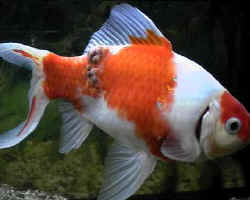
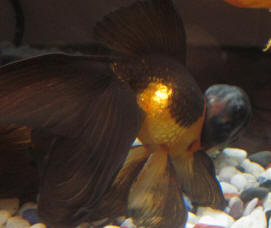
|
 |
New Print and
eBook on Amazon
Goldfish Success
What it takes to keep goldfish healthy long-term
by Robert (Bob) Fenner
|
|
Fish tumor on gill- please help 1/2/11
To whom this may concern,
I am deeply worried that my fish is suffering from the huge lump
on its gill. Unfortunately, my brother won him at the fair so I
do not know of its species. His eating habits seem to be normal
and he is swimming around the tank, although it does seem as if
the tumor is effecting his balance.
Hopefully the picture that I have attached will help. If you
could inform me of the best way of action, whether it is
euthanasia or treatment. It is weighing greatly on my
conscience.
<This is highly likely an example of idiopathic tumour...
Please read here
re: http://wetwebmedia.com/FWSubWebIndex/GFgrowthsFAQs.htm
Thank you for
your time,
Regards,
Jenny Petrie
<Welcome Jenny. Bob Fenner>
|
|

|
Re: Tumour/cyst on stressed goldfish 12/17/10
Hi Bob
<Hello Helen>
Thanks very much for your reply, very much appreciated. Im sorry to
reply so late, work, weather (bit rubbish over here at the moment tell
Peter hes not missing much and also that the Bowling Green pub as he
might have known it has closed!).
<He was just back visiting his mum, and I do think he mentioned
this>
I did many hours of research last weekend on goldfish diet and
ailments, and am pretty certain that George is suffering from
hole-in-the-head disease, caused by poor diet most likely. He doesnt
seem to be getting any worse fortunately, but is static, taking in some
food but not much interested in anything. Anyway, following on from the
research I also got concerned about the level of protein in the
flakes.
<Yes>
Unfortunately in my naivety I actually believed the pet store (who
ordinarily seemed to have been a good source of information) and what
it said on the tin complete system of goldfish food recommended by top
aquarists. I now know that they need greens and fish products, so have
ordered some ingredients to make my own gel food also, and have got
some freeze-dried Tubifex and bloodworms (says disease free on the
packaging heres hoping so!).
<I'd leave the last, insect larvae, out>
So theyll eventually have a mix of flakes (much lower protein), greens
and gel food, with some dried worms and Tubifex. Hopefully a much
better diet for them. I put some par-boiled spinach in the tank a
couple of days ago. George swam past it, but the other two had a good
chomp on it and seemed to really enjoy. I must follow suit!
Have been doing 20-30% water changes every other day to reduce the
nitrite back to zero. It was slightly higher previously (cant remember
the reading, but it was still within safe limits) but doubtless wont
have helped Georges condition. I wont be getting any more fish in the
tank, so will unfortunately have to leave them a bit crowded, but if I
do lose George then I certainly wont replace. At 20 gallons per fish,
two should be ok.
<Yes indeed>
When I returned home last night, Georges head lump looked to have been
sheared in half across the top. I did actually check the tank to see if
I could find bits of it, but couldnt, so maybe hed bumped in to
something and squashed/burst some of it. It didnt seem to be unduly
upsetting him, although it looks very sore as an angry red.
<Not to over-worry here. Such injuries generally heal fine on their
own>
Ive read both articles recommended, and looks as though more frequent
water changes are indeed the future. Theres so much conflicting advice
about how much water to change/frequency of changing. Im going to go
for 25% twice a week and see how I get on (200 litre tank). Will
increase in frequency if nitrite levels start creeping up (ammonia has
always either been zero or as near as Im careful not to over-feed).
Does this sound about right?
<Yes... this is about what I do, have done for decades>
Im trying to strike a happy medium between at least 20-25% which
suggests perhaps not quite enough. I used to do a 40% each week in the
old tank, but this was completely unsuitable for the number of fish and
so tended to get dirty much more often filter was never going to be
able to handle the waste.
<Nowadays, water quality being what it is... unless one can store,
treat, let new water set, it is best to just do the appreciable 20-30%
once a week. More filtration is always a plus as well>
It does make me angry that pet suppliers are so ignorant about the
animals that they sell. They sell goldfish bowls, and most will advise
a far too high a number of fish for the tank size, even when someone
does bother to ask. I hold my hands up to starting out as an ignorant
fish owner myself. I did a lot of research before I bought their first
tank, knew that it needed to be cycled and spent a couple of hours
picking the brain of the pet shop owner, who was himself an aquarium
owner. But its never enough. Both myself and the swimmy guys have come
a long way since that day, with a couple of sad losses, which is why Im
so hoping that George does rally as hes my responsibility and to date,
Ive failed him. But hey, at least Im still learning so it can only get
better!
<Ah yes!>
Am knocking the tank salt on the head I always thought it was something
to do with the osmotic effect of salt being leached out of the fishs
body and stressing it if there wasnt enough in the water!
<Not necessary, necessarily as you now know>
With best wishes for Christmas.
Helen
(a bit ignorant when it comes to keeping fish)
<But less so all the while. Cheers and happy holidays to you and
yours as well Helen. BobF>
|
My goldfish has a large cotton looking growth on his
nose. What is it?(RMF, viral?)<<>>
9/29/10
Hello,
<Salve,>
I have a goldfish that is 2 years old. He is in a 12 gallon tank
by himself.
<Much too small.>
He is fairly big, measuring about 7 inches long, so he produces a
good amount of waste (as most goldfish do).
<Most? All!>
A few months ago I was having a problem keeping his tank
clean.
<I bet.>
His ammonia level and Nitrate level would spike and I was having
a hard time getting it down.
<Yes.>
During that time he developed a bump on his nose that looked like
a little pimple but would get pink and bloody if his ammonia
levels got too high.
<There's no "too high" with ammonia. It's a
binary thing. Zero is safe, anything not zero is
dangerous.>
He also had gotten ammonia burn on tail and fins. I was able to
get everything under control by buying a larger filer (I bought
one that is for 20-30 gallon tanks) and putting in treatments
like cycle (biological
aquarium supplement) and Prime (removes chlorine, ammonia, and
nitrates)
<Prime is for conditioning tap water. It has NOTHING
whatsoever to do with the ammonia, nitrite and nitrate resulting
from your fish and the biological filter.>
and a little bit of salt to help his slime coat (and water
changes of course).
<Salt is irrelevant here and has nothing to do with the mucous
on a fish's skin. My worry is you're cherry-picking
factoids from the internet without really understanding the basic
facts. A Goldfish like this needs at least 25 gallons, and
realistically 30 gallons, to stay healthy. Period. End of
discussion.>
I'm happy to say that his tank is now nice and clean and the
water all tests great (no ammonia, low nitrate and nitrite etc.)
But my problem is that little bump on his nose has grown into a
huge growth!
<Indeed.>
I have tried everything to get rid of it. I have tried treatments
of tetracycline, Maracyn and maracyn2, Melafix and Pimafix and
nothing has made a difference. I swear it's getting
bigger.
<Quite likely so.>
Luckily its not interfering with him being able to eat and he is
acting like his normal self but I'm worried about what this
thing is. It looks like a cotton ball on his nose. What is this
thing?
<Probably viral. The issue with viral infections such as Fish
Pox and Lymphocystis is that they're related to the
environment. Precisely as you've observed, when stressed by
poor environmental conditions, fish
become subject to these wart-like viral infections, and over time
such growths become bigger and bigger. There's no cure as
such, because the fish will only heal once its immune system is
operating at 100% and the source of environmental stress is
removed. The details remain obscure, but studies on Lymphocystis
in the wild does seem to connect outbreaks with poor water
quality and above normal levels of heavy metals. A bacterial
infection will usually form a pus-filled sac, usually bloody and
sore-looking, and
antibiotics should shift such things fairly quickly. Untreated,
bacterial infections tend to kill the host fish very quickly,
within days or a couple of weeks. But viral infections of this
type are essentially benign if
untreatable. Lymphocystis commonly takes a year to clear up. I
don't think this is Lymphocystis as such because that
isn't common on Cyprinidae, but there are a whole host of
similar viral infections.>
What can I do to get rid of it?
<You can't. Given time the fish may heal on its own. Could
take many months though.>
I attached a picture. Any help would be great. Thanks so
much.
Kari
<Do read:
http://www.wetwebmedia.com/fwsubwebindex/goldfish101art.htm
http://www.wetwebmedia.com/virdislymphf.htm
Cheers, Neale.><<An irritated nares, environmental... I
agree with your direction here. RMF>>
|
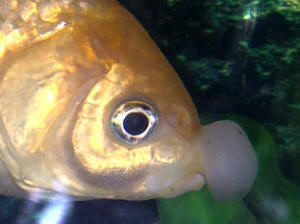 |
White lumps on goldfish tail 9/10/10
Hello:
I have an Oranda goldfish- about four months ago I noticed that he had
two small, white lumps between the rays of his tail. Both were in the
same spot and both are approximately 1 mm x 1 mm. This in not Ich.
I tried dabbing them with Biobandage, which didn't do much more
than stress out the fish. I thought it might be prudent to keep a close
watch on the bumps rather than attempting any sort of further
treatment. The lumps have stayed consistent in size, but today I
noticed another cluster of bumps forming- on the same side of the tail,
approximately an inch away from the original ones.
The fish is not at all stressed, but I am concerned that these might be
small tumors (?). I originally thought that one of the fine bones in
his tail may have broken when the aquarium shop netted him to put him
in a bag when I purchased him and that the lumps were deposits at the
injured site. Now I am not so sure. The tail is otherwise fine- no
signs of fin rot, red streaks or other damage.
Water parameters are great- Ammonia zero, nitrite zero, nitrate 15 and
pH 7.8. I vacuum the gravel regularly and do small twice weekly water
changes. The fish is alone in a 50 gallon tank and I have not
introduced any new plants or decor.
Any idea what this might be? Should I worry? I have tried very hard to
get a photo but the fish is not one to pose for the camera
Thank you for your advice:
Gina
<Finrot does start with congestion of the blood vessels in fin
membranes, and before they turn pink they can be grey or off-white for
some time. So that's certainly a risk. Fish Pox does affect
Goldfish, but it is distinctive, looking like blobs of candle wax. Fish
Pox is a tumour caused by a virus, and comes and goes at its own pace.
It can't be treated, though anything that improves water quality
and diet will speed up natural recover. It's not fatal. Hope this
helps. Cheers, Neale.>
re: White lumps on goldfish tail 9/10/10
Thanks Neale:
<You're welcome, Gina.>
I just Googled images of fish pox but am fairly certain this is not
what is affecting my fish. I will try to take a photo of the tail for
you.
<Useful.>
I hope it isn't poor water but this is possible since the fish has
just moved to a cycled tank. The bumps have been present since I
purchased the fish several months ago.
<I see. May well be viral then, or merely the fish equivalent of
warts.>
I was hoping to add a second fish to the tank but I will hold off until
I establish whether or not this is a contagious condition.
<Unlikely to be contagious. But I'd still wait 2-3 weeks, see
that first doesn't get worse, and only then add another
fish.>
Kind regards:
Gina
<Cheers, Neale.>
Goldfish bump/blister 8/26/10
Hello all at WWM,
<Hi, Sarah! Melinda here tonight.>
Thank you as ever for the fantastic service you provide. I'm just
emailing with a quick question about my goldfish today, which I hope
you'll kindly help me with. Unfortunately, a long dig through your
archives provided masses of info but no consensus, as I suppose is
usual when you have a large group of experts with different
opinions!
<Well, none of us agree on everything, and I am by no means an
expert.
However, I have seen my share of sickly-looking fish. I hope I can
help!>
My problem is that my goldfish has suddenly (i.e. during the day
yesterday) developed a round, pale bump or blister, located between his
eye and his gill.
<Ohhh, okay.>
The bump is slightly paler than the surrounding area, and it looks as
if there's a lump under the skin pushing up. There is no visible
injury, though there was some reddening close to the area this
morning.
<Okay. Sounds like the beginning of an infection. Not necessarily
anything to totally freak out about, and I'll discuss that
below.>
It's highly unlikely to be parasite-related as I've introduced
nothing new to the tank in about a year, and never anything
unquarantined.
<Okay, good.>
I believe it's likely to be damage from an injury, e.g. collision,
which perhaps has become infected (suggested by some WWM posts) or is
simply a bruise (other posts).
<Well, you could begin to go down the list -- possible injury from
tank mates? Sharp objects, such as decor? And also, do learn about
Columnaris, by using the search feature on WWM: I found some good
results using "goldfish Columnaris." There is no reason to
jump to this conclusion, unless the red spots begin to develop white
lumps on top of them. In this
case, you'd want to treat with Erythromycin, an antibiotic.
However, I would wait a little...>
I don't want to medicate unnecessarily,
<Absolutely.>
but neither do I want to leave an infection to run rampant.
<This is the thing, Sarah: infection does not often run rampant in a
tank which has excellent water quality (Ammonia, Nitrite of zero, and
Nitrate of less than 20), and in which the fish are being kept in
proper conditions, as far as chemistry goes. Please do read here, if
you haven't found it already: http://www.wetwebmedia.com/fwsubwebindex/fwh2oquality.htm.
This article gives specific guidelines for the necessary pH and KH to
keep goldfish. Please do adjust your aquarium accordingly using the
included (and may I say, amazing!) method. I'm guessing that since
you're a well-read WWM'er, your aquarium is up-to-par, but
wanted to mention these anyway. If you find anything that's not as
it should be, that should be fixed. If you still find your fish is
exhibiting these symptoms, I'd medicate in the above-mentioned
fashion, with an antibiotic. However, if you water quality/chemistry is
optimal, I'd give this a few days. You'd be surprised what
shows up on fish, only to disappear a day or two later! If you're
doing what you can do for your fish, and their immune systems can
operate optimally, things seem to come and disappear very quickly.
Please do let me know if you have any questions about water
quality/chemistry.>
So, I'm hoping that from my description it'll sound familiar to
one of the crew, and they may be kind enough to advise accordingly.
<Does sound familiar. In my (totally non-scientific -- my major is
English!!) opinion, what you have here is a "fish bump,"
(again, my own term,) and it needs no medication unless you continue to
see the problem progress, or if conditions are not optimal for the fish
to heal. If you do find, after testing, that water is not of optimal
quality/chemistry, do what you need to do to get it that way. If you
have any questions, feel free to write back.>
Thank you for your time, and for all the help your site has offered me
in the past.
<I hope I was of some help!>
Kind regards,
Sarah
<--Melinda>
Re: Goldfish bump/blister (also, a suggestion for WWM -- Bob, could you
give input on this?)<<RMF>> 8/26/10
Dear Melinda,
<Hi Sarah!>
Thank you very much for your reply - it's really appreciated, and
you were very helpful. Regarding your 'non-scientific'
designation of the offending article as a "fish bump" (hey,
that's what I call it) I'm not sure how relevant a scientific
background is to volunteering for WWM
<<It, the designation, or reality, is not.... There are amongst
us, academic scientists, but all here possess useful, applicable
knowledge however derived... and as importantly are capable and
desirous of helping others>>
- while it no doubt adds something, it seems to be experience and
passion for helping sick fish that matters (which, from the replies
I've read from you over the past few months, you obviously have in
spades). Plus, I'm sure your major in English helps keep
everyone's grammar up to WWM standards! ;)
<Ha! Many e-mails we receive do much to further my interest in
saving the English language before it's too late. As for my
interest in helping folks with their fish, every old fish tank I sell
on craigslist comes with plenty of free advice, whether it's
desired or not!>
Back to my fish: thank you for your answer. I am indeed a long-term WWM
lurker and shameless FAQs addict - however, I'm very happy to have
you reiterate the basics. Better to catch everyone, including those who
should know, just in case they don't (if you take my slightly
convoluted point).
<Absolutely.>
Regarding my current problem, I've changed 30% of the water in the
tank, made sure the filter media is reasonably clean and tank stats are
at usual levels - no nitrite/ammonia, pH 7.0-7.5, nitrate under
5mg/l.
<Oh, good.>
I think your diagnosis of an infected injury seems reasonable
(Columnaris is an old enemy who will get the boot very swiftly if he
shows his face, believe me).
<He is an old enemy of mine, as well. I had a tank of Goldfish that
seemed to be plagued by Columnaris for a year or so -- as soon as
I'd think I'd beaten it, it would show back up.>
I'm definitely in favour of giving it a few days to see how things
go; fortunately I have a few days off anyway, so I can keep a close eye
on him.
<That's good news. Hopefully, you'll see this go away. If it
doesn't go anywhere within a couple of days, or begins to look
worse, I'd go ahead and treat him.>
<<I have had good success w/ treating Chondrococcus/Columnaris w/
Neomycin Sulfate... 250 mg./ten gallons...>>
As for cause, his tank mate is unlikely to be responsible (a small
Black Moor) and I check any decor for sharp or protruding bits before
it gets anywhere near the tank, so I don't think that's it.
However, I have recently installed a new filter (with old media, of
course) which had quite a strong current at first, so I suspect the
poor thing just got tumbled
about a bit before I spotted that he was struggling and turned the
current down. So it's just a case of wait and see, with crossed
fingers.
<Yes, I think I'd give him a couple of days, but no more than
that.>
I do have one query, however. I've never used an antibiotic for my
fish before (have had good results with off-the-shelf antifungal meds
such as eSHa 2000 when needed), but I understand they're hard to
get in the UK.
Would this be a matter of seeing a vet, do you know? Hopefully I
won't need this piece of advice, but I'd like to be prepared
just in case.
<Check out this page:
http://www.wetwebmedia.com/fwsubwebindex/fwfishmeds.htm.
It's a table which lists medications available in the U.S., and
their equivalents in the UK. It would be a handy reference just to keep
on hand, as well. Do any of the medications for bacterial infection
sound familiar?>
Incidentally - thought I'd sneak this in at the end, as I know how
Bob and co. are constantly looking for improvement to the site - is
there any way that the search function could be made to search WWM by
default, rather than Google? If it's a simple matter then that
might be worth doing, as I sometimes miss the button and search the
whole web by mistake (could just be me, of course). Just thought it was
worth mentioning. :)
<It would be a wonderful change. I use the search feature quite a
bit myself, and have found some comical results to certain terms which
have completely different associations in the non-fishkeeping sense if
I forget to hit the "Search WWM" button. I am not sure if
it's possible, but will add a note for Bob requesting his
input.>
<<The one specific search page: http://wetwebmedia.com/Googlesearch.htm
does solely search WWM... This page is linked on the left shared border
as "Search Feature" on all pages but the root Home. I
consider it more valid to offer a/the option to allow folks to select
the wider choice>>
Thank you again for your advice, and hope you have a lovely day!
<No problem -- I'm glad I could help. I hope yours goes well
also.>
Warm regards,
Sarah
<--Melinda><<BobF>>
|
Abnormal growth on dorsal fin [Bob, does this look
viral to you?]<<A growth of some sort; I'd leave it
be...>> 8/22/10
Hello,
This is a follow-up to discussion in April. Attached are 2 photos
of growth on fin. I have added more nutrition to diet in form of
flakes but growth still there. He still eats a lot of green peas
which controls his air bladder problem. Water quality is decent;
tested periodically at PetSmart.
He is otherwise healthy. Will it eventually fall off? What would
happen if it were cut off? (not that I have the nerve for
that...)
Linnah
<Hello Linnah, this looks to me like something viral. A cyst
of some kind. I'm asking Bob for a second opinion here. Viral
diseases of fish tend to be untreatable directly, just as they
are with humans. Instead they come and go according to background
factors such as water quality and heavy metals in the water.
Review and act accordingly. If the viral infection isn't
serious, it should clear up, though Fish Pox for example, which
does affect Goldfish, can take many months, even a year to do.
You might try a broad spectrum antibiotic just to see if it's
a bacterial infection, though it doesn't really look like one
to me. Cutting fins is certainly possible, but really needs to be
done by a vet, in part because you can damage the fish
while handling it, but also because there's a risk of
secondary infection even if you do cut away the cyst. I have seen
vets and zoologists do such "surgery" to treat
Lymphocystis on large fish, but I wouldn't ever recommend
hobbyists try it. In the meantime, check the tank is big enough,
ensure good water quality, use a water conditioner that
neutralises copper
and other heavy metals, and hope for the best. Cheers,
Neale.>
Re: abnormal growth on dorsal fin [Bob, does this look
viral to you?] 8/23/10
Okay, thank you Neale! That gives me some guidelines to work
with. Maybe heavy metals in the water, which comes from our well
although filtered
Linnah
<Glad to help. But let's see what Bob has to say today.
Cheers, Neale.>
|
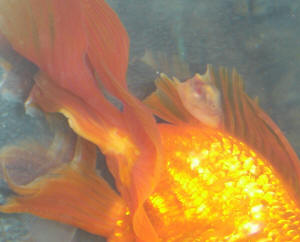 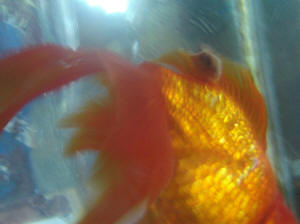 |
abnormal growth on dorsal fin 4/28/10
Hello,
You helped my 7-year-old fantail goldfish through a
crisis last year; thank you! Now, over the past few months I have
noticed what seems to be a growth in the midsection of the dorsal fin.
It is whitish, thick, tapering to a point at the outer edge. I
can't locate any info on such a condition; doesn't quite fit
the descriptions of fin rot or fungus. What do you think it might
be?
Thanks, Linnah
<Hello Linnah. Difficult to say without a photo. Fungus is usually
distinctive, since it's "furry", like cotton wool. Finrot
tends to begin with pinkish blister-like swellings on the fins.
Eventually these decay into open wounds, and the fins become raggedy as
the fin membrane dies away. One problem Goldfish sometimes get is Fish
Pox, a benign viral disease that goes away by itself. The cysts or
tumours it produces usually have a glossy appearance rather like candle
wax. It's comparable to Lymphocystis in being triggered by some
shortcoming in the environment,
typically poor water quality, but potentially things like heavy metal
poisoning or inadequate diet. Ensuring optimal conditions and a
healthy, vitamin-rich diet should allow the fish to heal itself, given
time. Cheers, Neale.>
Fantail with small ulcers 4/23/10
Hi Crew
I have a 1 1/2 inch Fan tail that has been bottom sitting frequently
and now is showing two very small red spots where she rests on the
glass bottom. She is still eating enthusiastically. This fish has not
grown much in 2 years
<I'll say! How big is this tank? If Goldfish are kept in
too-small tanks, they can become stunted, and while this may or may not
be directly harmful in itself, it does mean that the fish is more
likely exposed to conditions detrimental to its health. At two years of
age, a Goldfish should be about the size of your hand.>
but has always appeared healthy and does well on Veggies. She has swim
bladder problems on pellets. With Spinach and peas, she does well.
<Fine.>
She seemed to be having some trouble with her mouth on one side and was
doing some yawning, so I dosed the tank with Aqua Prazi and we are on
the 3rd day after treatment. One of the small ulcers appears larger
tonight.
<Very like bacterial, opportunistic. Would assume Finrot or similar,
and treat accordingly.>
I put in an RO
<Reverse osmosis? I assume with some sort of Rift Valley cichlid
salt mix
added? Goldfish cannot tolerate soft water.>
and I think the water parameters are good, thanks to Neale's
help.... Ph consistent 8.5 KH 9 GH still high but working on it.
Nitrates
below 20 and temp at 72.
<Do check tank size as well. The relationship between aquarium size
and health is very strong.
http://www.wetwebmedia.com/fwsubwebindex/gldfshdisease.htm
http://www.wetwebmedia.com/fwsubwebindex/goldfish101art.htm
For a standard issue Fantail, it's hard to see them being kept
humanely in less than 30 gallons.>
How can I treat the ulcers? And can I treat them with Prazi in the
water?
<No.>
I do have Metro Med and Medi Gold but she doesn't do very well on
pellets.
I could try soaking the pellets before feeding.
<Any anti-Finrot antibiotic or antibacterial should work. Melafix
may help too, but it's a pretty unreliable medication.>
Thank you... I adore this little girl and don't want this to get
out of control.
Any suggestions much appreciated.
Amy
<Cheers, Neale.>
Re: Fantail with small ulcers
<...for Neale, I assume?>
sorry I forgot to mention tank size. She is in a 25 gallon with one
other 2" fish.
<A little on the small side.>
My other fish have grown normally, but she never has. ( I have 2 other
tanks) The water is not soft.... I have the other problem. I've
been working on getting the GH down with RO water. It was unreadable 3
weeks ago and is now down to 18 drops of API. I think other parameters
are good.
<I would tend not to worry too much if you have hard water. Or if
you must, a 50/50 mix of hard tap water and RO water generally produces
something good enough for Goldfish.>
I had some Epsom in the tank because of her occasional swim bladder
problems. I assume I cannot treat the ulcer as long as I have Prazi in
the water?
<Medications will usually be metabolised by bacteria within 24
hours, but a 25-50% water change will flush out any that
remains.>
Do I carbon out the Prazi and treat for bacterial infection .... or
wait 3 more days till the Prazi treatment is finished?
<It the Praziquantel only needs to be used for a couple more days,
then you may want to finish that course of drugs, do a water change,
and then use the Finrot medication.>
She is doing a lot better, more active after the Prazi so I think she
probably had flukes.
Thanks Neale.
A
<Cheers, Neale.>
Further goldfish problems :( 2/25/10
Deeply sorry to bother you again but I can't work out what the
problem is... Single goldfish, about 12 or 13 years old in a 100-odd
litre filtered tank. Moved abroad last November, have had on-off
problems ever since, two
cases of fin rot so I've been changing the water regularly. Thought
the tank had finally settled out, maybe not!
<Oh dear.>
Now I'm seeing a dark red sore at the base of the anal fin, far
side of the fin from the anus. The fin itself seems okay but he keeps
it folded up at the moment. He hasn't had this before.
<Likely some sort of Finrot; assuming that's the case, standard
Finrot medication should do the trick. Avoid ones based on tea-tree oil
(they're unreliable) and instead use a proper antibiotic or
antibacterial. In the UK, I've found eSHa 2000 as being economical
and effective. Do remember to remove carbon from the filter (if used)
while medicating.>
While the sore is red, there's some white on or in it, but not
outlining it, and something pale/white protruding from the red on one
side, not long and stringy like I imagine a worm would be but more like
when a potato starts to bud.
<Sounds like it's an ulcer.>
I can't tell if it's something growing out or like an infected
spot swelling up. Can't see any other symptoms. Behaviour as
normal, other fins open and he's swimming and eating as usual. The
only change in diet is I recently gave him some lettuce. Otherwise
nothing's changed. Do you have any idea what's causing the sore
and what I need to do?
<See above.>
My access to treatments here is quite limited and I can't get water
test kits to give you any values!
<Finrot is almost always down to water quality, so at minimum you
need to have the nitrite and pH tested. Goldfish need hard, basic
water, so a pH around 7.5 is good. Soft water isn't at all good for
them, and should be hardened before use, for example by using a quarter
to half dose of a Rift Valley salt mix (which is easy to make and costs
very little).
http://www.wetwebmedia.com/FWsubwebindex/fwh2oquality.htm
As for nitrite and ammonia, these should be zero.>
I've done a 20-30% water change about every other day for the last
week.
<Cheers, Neale.>
Re: Further goldfish problems :(
Fabulous! Thanks so much. I have an old test kit but I don't really
believe what it tells me. Can I have Finrot if the stats are pH7, NO2
0-0.3 (lowest category it can show), KH 2?
<Sure. Indeed, the carbonate hardness (KH) is so low, that you
likely have soft water. This is common in some parts of the UK, notably
Cornwall, West Wales, much of Scotland. Really anywhere not on
limestone or chalk.
Goldfish hate soft water. Harden the water using a Rift Valley salt
mix, which as indicated in the last e-mail, is easy to make and costs
pennies a month.>
I think it must be past its sell by date... or maybe the softness is
the real culprit behind these recurring problems?
<In part, likely yes.>
I'll treat with Ektol for Finrot/ulcers but it kills the filter
bacteria- back to square 1. Again!
<Used correctly shouldn't kill filter bacteria. Cheers,
Neale.>
|
Ryukin in trouble, admonition of worth re "salt
addn." 12/11/09
Greetings, Guardians Aquatic,
<Hello Violet,>
I have two young fancies (>3") in a 20 gallon tank, well
aerated with a HOB filter meant for a tank twice the size to give
them a high turnover rate and decent current.
<While acceptable for now, do understand adult Goldfish will
make a 20 gallon tank very messy, by which I mean murky water and
high in maintenance. If at all possible, upgrade this tank to
something 50% larger.>
They have been healthy and spry for many months in a well-loved,
previously established tank (0 NO2, 0 NH4, >10 NO3).
Temperature in the high 60s, low 70s, fluctuates a little when it
gets cold at night, but never drops below 67 or so. 25% water
changes twice a month.
<Fine.>
The water in So California is hard out of the tap, and I add a
homeopathic dose of aquarium salt: 1 tsp/ gal.
<Do understand homeopathy -- when it works at all -- works via
the placebo effect. For obvious reasons, that isn't going to
work with animals, since they have no idea you're adding salt
and it's going to make them feel better. Indeed, the addition
of tiny amounts of salt to freshwater aquaria is completely
pointless. Try asking someone why salt helps. You'll get lots
of arm waving about raising hardness (which it doesn't do)
and steadying pH (which it doesn't do either). Maybe
something about improving their electrolyte balance (try asking
them what electrolytes are) or maybe even something about the
slime layer on their skin getting thicker (try asking why
that's helpful). What I'm saying is that the whole salt
thing is completely misunderstood by a huge section of the hobby,
largely those without much of a science education I suspect. Salt
detoxifies nitrite and nitrate, so can be useful in the short
term to get fish through, for example, the cycling process. Salt
can also be used to deal with certain parasites, either added to
the tank (as in the case of Ick) or as a strong salt solution dip
(as used to weaken skin flukes before manually removing them).
Marine salt mix, as opposed to aquarium salt, can be used to
raise pH and hardness levels, but only when salt-tolerant fish
species are being used, typically livebearers, some killifish,
and of course brackish water fish. In all other situations, the
routine use of salt is at best a waste of money, or otherwise a
potential stress factor. Regular Goldfish actually have quite a
high tolerance of brackish water, Fancy Goldfish perhaps less so,
but in any event they DO NOT need salt.>
They eat mostly sushi Nori, with peas once a week and
"Emerald Entree" frozen food once a week. Sometimes
other blanched greens from the fridge or bloodworms once in a
blue moon if I cut off too much for my Betta.
<Fine.>
My Black Moor is perfectly healthy if his outward signs are
trustworthy.
My Ryukin, however, started showing signs of lethargy about a
week ago, so I started keeping an eye on her. I noticed that the
Moor was interacting with her oddly, doing something I've
never seen goldies do before - he'd
nudge under her and then sorta push her upwards, toward the
surface, like dolphins do to sick buddies and drowning
humans.
<Be careful not to anthropomorphise.>
No nipping, just nudging. Spawning behavior perhaps?
<Yours are probably a bit young to be spawning. Mature males
will develop spawning tubercles on their heads, and rather than
nudging, they chase.
Vigorously! It's actually pretty uncommon for Goldfish to
spawn in aquaria, which underlines the fact psychologically they
need much more space than indoor aquarists usually give them.
Nudging between fish, especially when just two Goldfish are being
kept, is much more likely to be a quasi-aggressive behaviour
related to the pecking order. These fish are intensely social
animals, and like all schooling fish, they aren't
"friends" but a collection of bullies, each jockeying
for the position of top dog. When you keep just two, one
inevitably becomes the dominant fish and rules the roost. (Notice
how I'm using all these other animal-related expressions to
remind you how common this type of behaviour is among social
animals?)>
Anyway - I put her in an isolation net because she was weak,
current blowing her around more than normal, and I didn't
want him to bully her.
<Isolation in another aquarium fine; isolation in a breeding
trap or net not so fine. I call these traps the "breeding
traps of death" because fish placed inside them usually end
up dead. Most aquarists completely misunderstand their usage.
Contrary to what to illustration on the box shows, you don't
put adult fish in breeding traps. You put the fry in them.
When breeding Guppies or whatever, you stock the tank with
floating plants where the fry can hide, and each time you see a
fry, you net it out and pop it into the trap. That way the net
contains just very small fish, and does so for just a few weeks
until they're big enough to be set loose again.
Stick an adult fish in a breeding trap and it'll feel
confined, it'll receive much less water current than before,
and chances are it'll become stressed.>
I also started feeding her Jungle brand anti-bacterial medicated
fish food a few days ago, since there was nothing external that I
could diagnose, and I figured anything internal would probably be
bacterial.
<Not a good way to work. Diagnose first, treat second. If you
can't diagnose, then do not treat. Wrongly medicating a fish
is more likely to do harm than good, and usually ends up as a
waste of money.>
Not much change in three or four days - still in the net, still
lethargic, but still eating the pellets ok.
<Let it loose in the big tank or a hospital aquarium if you
have one (and you really should).>
Well, today she's developed a reddish and white rash (?) on
her face and what looks like a blister of some sort on her
forehead. She's normally got a really smoothly sloped
forehead typical of the Ryukins. I've attached pictures, but
the red blotchiness under the white spots doesn't really
translate.
<The white patches are either mucous or dead skin. Can't
really tell.
Mucous will be off-white in colour and obviously slimy. When
Goldfish are stressed, e.g., exposed to poor water quality, they
create extra mucous.
Indeed, all fish do this. But on Goldfish their unnatural colours
mean this mucous becomes much more obvious. Black Moors are
famous for this, but Ryukins and other varieties with weird heads
often show this too. Dead skin
will look like dead skin, so should be easily recognised. If
there's red patches associated with dead skin, that's
almost always Finrot. The red patches are areas of bleeding and
congested blood vessels, and typically associated with bacterial
infections. As the bacteria multiply, they clog up small blood
vessels, creating first red patches and then open sores.>
The white looks a little like ich, but I've had ich in other
fish before and it looks different. I've also never seen ich
happen just locally on the face and be accompanied with red
splotches or blisters. Some of the white appears to be sloughing
off too. Any ideas?
<See above.>
Unfortunately, I'm without a quarantine tank right now
because I had to empty it to use with a sick tree frog. (When it
rains it pours...I was ill last week too. So was the cat. I'd
hate to think all my familiars are so tapped in to me... ;-)
I'm hoping whatever meds you recommend wont stress out my
Moor too much.
<Actually, the "cure" is checking the water quality
and water chemistry.
Almost always, Finrot is triggered by either environmental stress
or physical damage. Physical damage tends to be fighting,
careless netting, fin-nipping, etc. In terms of environmental
stress, check the pH is nice and high (around 7.5) and stable.
Hard, basic water is the order of the day here. Make sure you
have 0 ammonia and 0 nitrite. Instead of adding salt to the tank,
consider adding a Rift Valley cichlid salt mix to raise the pH
and carbonate hardness.
http://www.wetwebmedia.com/FWsubwebindex/fwh2oquality.htm
Half the normal dose should be fine. Once you're sure
everything in the environment is optimal, medicate as for Finrot.
Skip the junk meds like tea-tree oil, and concentrate on a good,
reliable brand like Seachem
ParaGuard or Mardel Maracyn.>
He's doing just fine and I hate to treat a healthy fish.
It's feasible I could put him in my 55 gallon with two larger
fan tail goldies, but they're at a higher temp because
they're in with a Bristlenose and some guppies, so I'd
have to acclimate him slowly, and I'm not really sure how
I'd do that without another tank.
<As per the "drip method" for introducing new
fish.>
The wealth of info on this site has benefitted me more than you
can possibly imagine over the years, and this is the first time
I've had to write in. I hope you can shed some light, Frida
is a special girl.
<Cool.>
Cheers, Violet
<Hope this helps, Neale.>
|
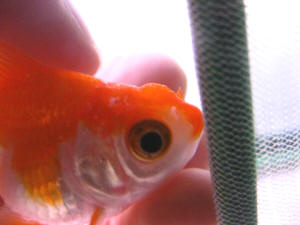 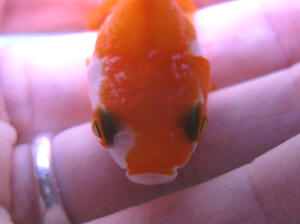
|
Re: Ryukin in trouble
12/12/09
Hi Neale,
<Violet,>
Thanks so much for the diagnostic help. But just for
clarity, you didn't mention anything about the blister,
and that's the dominant feature of the visible
pathology.
<It's all part and parcel of Finrot.>
It has swollen more today and looks translucent. Sorry the
first image is blurry, but it's the best profile shot I
could get of the blister. And yes, the white patches are
clearly dead skin today - sloughing off to leave a sort of
raw- looking texture. The base of her dorsal fin also looks
to show the same rawness today, while it was fine
yesterday. Fin rot is a fungal infection, yes?
<No. Finrot is bacterial. It's essentially gangrene.
A secondary infection of things like Aeromonas and
Pseudomonas that under normal circumstances the fish's
own immune system would prevent. When the fish's immune
system is weakened -- typically by environmental stress --
these bacteria "eat" away at the fish.>
Would the week of sullen lethargy + no visible physical
signs + sudden onset of facial blister and skin trouble be
typical of just fin rot, or could she have something else
going on with her that may have weakened her and paved the
way for the fin rot?
<Indeed.>
I put her in the net for a few reasons - so she
wouldn't get blown around by the current against her
will anymore, so the Moor couldn't push her around
while she healed, and so I could gauge how much of the
medicated food she's getting. (I knew they wouldn't
be pushing each other around for the same reasons as
dolphins do, but that was the best way I could think of
describing the motion.) I took her out and she sunk down to
the bottom immediately.
<Not a good sign.>
The Moor's a bit of the from- underneath-nudging,
seemingly just to get her moving. I am watching them
closely and he's done no nipping at all. They are
situated ON my desk, so the observation of these little
ones is easy.
I've had my other two goldies in the 55 gallon tank for
three years, and they've never exhibited any "top
dog" behavior, and they have also been situated
adjacent to my work space for much of that time so I
observed them quite a bit.
<A-ha! I suspect you know the answer to this. The bigger
the group, the more "balanced out" the behaviour
tends to be. It's also probable that males are more
aggressive than females, and without sexing your fish
(difficult outside of spawning season) you can't tell
if you've got three males together, three females, or
some combination.>
(New house recently- they're in the front room now.)
They have always been like two peas in a pod, even when
they were in a much smaller tank as juveniles. I had a
third goldie in with them for the first year, and she was
also not aggressive, which is why the Moor's behavior
is surprising to me.
<On the whole Goldfish do get along, even in pairs. But
aggression does occur. It's a lot like any other
gregarious animal, whether people, dogs or horses. Yes,
they basically want to be in groups, but at the same time
there are tensions, and you can't always predict
what's going to happen, only do your best to manage it
as best you can.>
The water quality tests pristine, as previously reported,
and the pH is at 7.5.
<Perfect.>
The general hardness and carbonate hardness are always as
high as my test kit will go, so they could be anywhere at
or above 180 mg/L and 240 mg/L respectively.
<Again, good.>
Based on your suggestions, I'm not sure what I could do
differently here, and I've gotten mixed messages about
the salt thing for goldies right here on WWM from other
FAQs, which is why I settled on the dose I have been giving
them. I figured it couldn't hurt, and if it helped them
out in any way, well then, money well spent.
<With Goldfish, there may be benefits in the short term
at least, but it's also important to understand why
you're adding salt. In a badly maintained aquarium with
non-zero levels of nitrite, adding a little sodium chloride
may well help. Likewise, if water changes are minimal, so
nitrate levels are sky high, sodium chloride may help.
These are two good reasons salt was often used in the past.
Aquarists didn't really understand why it helped, but
via trial and error had learned that it did. The parallel
would be how until the 1850s everyone drank beer instead of
water, even children and pregnant women. It was safer than
the water, and even though people knew nothing about
bacteria and how they caused disease, those people who
drank water instead of beer ended up sick. But even
allowing for this, we don't recommend people drink beer
all the time today. Whatever benefits it has relative to
untreated water, it is less safe, or at least less healthy,
than treated, chlorinated tap water.>
It really is pennies per dose, so the cost is almost
negligible. Do you suggest that other members of the WWM
crew recommend salt for goldies wrongly?
<There's a difference between adding salt for
therapeutic reasons, and adding it out of habit. Since
Goldfish tolerate brackish water, the harm is minimal,
perhaps non-existent. But there's no real advantage to
adding salt if the aquarium is clean and well managed. Do
distinguish salt from Epsom salt, which is used for quite a
different reason. Also Rift Valley salt mixes, though they
contain sodium chloride, are used for different reasons as
well.>
The only thing that has been any different with this tank
recently is the addition of a live plant that turned out to
be too tall for the 5 gal Betta tank I intended it for.
This was 2-3 months ago. The plant was removed after a
brown algae bloom happened (the tank gets quite a lot of
natural light during the day, and I inevitably turn the
artificial light on when I'm working at my desk). I
cleaned the majority of the algae off of the artificial
plants and larger rocks and put the live plant in the 55
gallon, which has several others and where everything seems
to be happy. Besides that episode, this tank's
parameters have been set and stable since before I added
these babies 6 months ago. I test about once a week out of
habit.
<I doubt the plant is the problem here.>
I have on hand API's Fungus Cure, which lists 3mg
Victoria Green and 30mg of Acriflavine per packet, each
meant to treat 10 gallons. I have enough for one full
prescribed treatment of this tank: 4 packets. I would like
to begin treating the tank now, so is this sufficient or
should I wait until tomorrow (as the hour is again late,
15-hour conference today) to go to the LFS to hunt down
some Maracyn? (I know the LFS carries Maracyn Two, not sure
about regular Maracyn.)
<Whatever you use, choose something that either treats
Finrot or treats Finrot and Fungus; I don't think an
anti-fungal alone is what you want. If you happen to use
carbon, which you don't really need (again, old
school!) don't forget to remove when adding
medication.>
Your advice is most appreciated.
Cheers, Violet
<Cheers, Neale.>
|
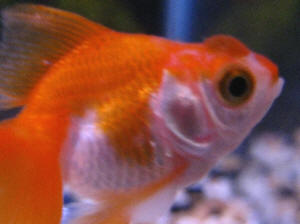 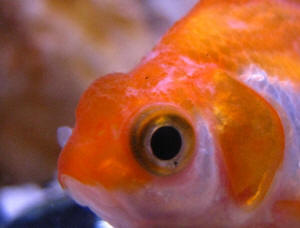 |
|
Goldfish problem, hlth. - 10/24/09
Hi
Can you tell me what is wrong with this fella. He has a big lump
growing on his neck
http://www.youtube.com/watch?v=g81PKyUhRDs
Mike.
<This appears to be a tumorous growth of some kind... likely
bacterial or virally mediated. All one can do presently is offer ideal
water quality and nutrition and hope for improvement. Please see WWM
for Goldfish re both.
Bob Fenner>
Re: Goldfish problem 10/24/09
Hi Bob ,
<Mike>
Thanks for your reply. I did let the water get bad so may have caused
it.
His fins did get dark on the edges but that has cleared up. I was away
for a couple of months and the people taking care of them let the water
go to hell.
<Ahh, a shame... I change a good deal of water on my goldfish
weekly...
along with my "Sunday routine". Cheers, BobF>
Thanks again
Mike
|
Sick fish 10/23/09
Hi
<Hello,>
I've got a 120 litre tank with 5 fish in, 2 of them are sick
and I have had 2 other fish die.
<If all your fish are Goldfish, and they're all as big as
this one, environmental conditions are almost certainly to blame.
A 120-litre (~30 US gallon) tank is adequate for two, maybe three
Goldfish, but not five. This does also assume you're offering
good water conditions, primarily through generous filtration and
regular water changes. For Goldfish, I'd be aiming for a
filter with a turnover at least 6 times the volume of the tank,
i.e.,
6 x 120 = 720 litres/hour. Water changes should be 25% per week,
at minimum. Goldfish prefer hard, basic water: aim for pH 7.5,
hardness 10+ degrees dH.>
I've included 2 photo's of the ill fish. I don't feel
that they have dropsy but possibly some sort of parasite or other
disease.
<Looks like ulcers of some sort. Would assume simply
optimising water quality and/or chemistry, and treating with a
suitable Finrot medication such as eSHa 2000, would do the trick.
Remember to remove carbon, if used, while adding
medications.>
Please can you help at all because I have been looking on the net
for a diagnosis. At the moment I have been treating with
Anti-Internal Bacteria and salt, whatever it is, is very
persistent and contagious.
<Interpet Anti-Internal Bacteria is possibly the most useless
product ever made. Never heard of anything being cured by it. As
for salt, while this can reduces the toxicity of nitrite and
nitrate, and can be used to treat Ick/Whitespot, it isn't a
miracle cure, and shouldn't be used unless you have a clear
reason to do so.>
Thanks Mr S Glover
<Cheers, Dr. N Monks.>
|
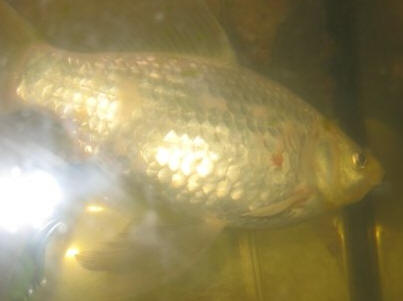 |
|
Red Cap Oranda sickness 10/22/09
My redcap Oranda has a very large bulge on his head above his
eye... It is not his head. It looks like it is weighing him down
because he stays at the bottom of the tank bent over. He is alive
and has been like this for about the last week... This has
happened before, but not nearly as big and went away... Please
help.
(ps.- he has been alive for at least five years... I know he is
very old, but he has been fighting these last few days and I
believe he can make it).
<Five years is not even adolescent, let along "very
old" so let's not bring age into this issue. Goldfish
can live for 30 years! Looking at the fish and looking at the
tank, I'd be fairly confident saying this was some sort of
environmental issue. Do read here, making note particularly of
diet, water chemistry, water quality, filtration, and tank size
issues:
http://www.wetwebmedia.com/FWSubWebIndex/goldfish101art.htm
As for treatment, fixing the environment will help but it
probably won't by itself cure the weird bulge on its head. If
the bulge is some sort of bacterial infection, like a pus-filled
sac or ulcer (I really can't see from your photos) then an
antibiotic might help. If the thing is a tumour though,
there's nothing you can do, though a vet might be able to
offer some advice. I'd certainly pick up the phone and call
your vet anyway.
Cheers, Neale.>
|
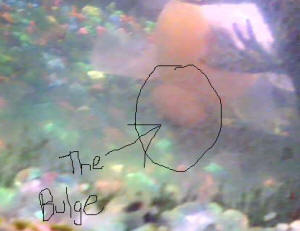
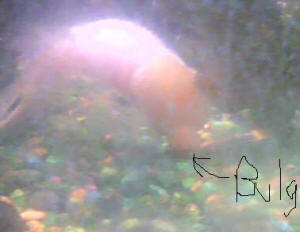 |
Goldfish Bump I recently noticed that my goldfish has a large
white bump on its upper back and I'm not sure what it might be.
What do you think it is and what should I do? Thanks for you time.
Amanda <Hi Amanda, Don here. Could be a lot of things, from a simple
bruise to a protozoa infection. Even poor water conditions. Do you
change his water? What size tank? Have a filter? For now I would start
doing daily partial water changes and add a table spoon of aquarium
salt for every two or three gallons on water. If he does not improve
try a medicine with Metronidazole. Good luck>
Goldfish Bump I found out that my fish has Ick. Is it
curable? <Sure. But first let's make sure that's the
problem. In your last email you said he had a "large white
bump" on his back. This is not Ick. Ick shows on a fish as tiny,
salt-like spots. There may be one or dozens, but they are always tiny.
If your tank has been infected with this parasite, the advice I gave
before is a great start. Change the water and add salt. I would just
that you should siphon the water from the bottom of the tank. Email me
back the tank specs I asked for earlier. Include a clear description of
what you are seeing on the fish. I want to help, but I need more info
concerning these conflicting emails>
Upside down Goldfish Hi, I have had my goldfish (which I
think is a Chinese goldfish) for about 3-4 years now. for the past few
months it had been floating on its back, but after reading your website
questions and answers I now know what that is. It seems pretty healthy
though swimming around because its not always on its back. But this
past week it got a huge lump on its hind tail. It is round and is
pretty much the same color as its fin but it has a hint of grey tint.
I'm not really sure exactly what it is, but I didn't think fish
could get cancer or tumors but maybe I'm wrong. Could you give me
some advice? < Fish do get tumors, but there is not much you can do
about them. more likely I would guess that it is a bacterial infection
so I would treat it with Nitrofuranace. It may be an internal parasite
too so Pepso food would take care of that. If it turns out to be an
internal bacterial infection then I would treat it with
Metronidazole.-Chuck> Thanks A lot Jenny
Lump on Goldfish My goldfish is about 12 and although seems
healthy enough it has had a black lump on his back for a while now and
now seems to be protruding more. It is between his head and fin and it
is under his scales. He has also turned a silver colour over a long
period of time. Any suggestions what this is and how I can help him?
<Hi, Don here. There is a parasite that would cause this black lump.
And it is more common in fish breed or raised outdoors, as are most
goldfish. However it has a complex lifecycle involving a bird as a
secondary host. Unless the fish is eaten by a bird, the parasite can
not reproduce. So this is unlikely unless he is a pond fish. No cure,
but they cause little harm. More likely it is a tumor. No real cure for
a tumor either, but many fish can live years with one. As to his color
change, it is normal for a goldfish to change color as they mature. But
it could also be a sign of poor water quality. Increase the number of
water changes and see if it helps. Good luck>
 |
New Print and
eBook on Amazon
Goldfish Success
What it takes to keep goldfish healthy long-term
by Robert (Bob) Fenner
|
|
|

